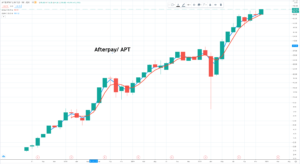
Afterpay and the difference between new ‘new highs’ and another ‘new high’

Afterpay APT Buy @ A$110 MV: A$28.9bn Next figures: 3 March Times recommended: 8 First recommended: A$54.52 Last recommended: A$101.85 (£1=A$1.77)
A new high for a share or index is always important. It is part of what a bull market is all about, part of an endless (hopefully) succession of new highs. But, in terms of the action you should take new highs are not all the same. In the chart above you can see that Afterpay is making what I call a new ‘new high’. The shares have been bumping up and down around A$100 for the last four months but in the last two days they have punched what looks like decisively higher. Nothing comes with a guarantees in the stock market but I would suggest to subscribers that if you hold these shares now is a good time to buy some more; if you don’t yet hold them now is a good time to open a position. Another new high is where a share or market has already broken up from consolidation (a new ‘new high’) and is forging higher in an extension of the uptrend.
Not that I want to discourage you from buying into an uptrend. It is more risky but it is still an excellent time to buy, especially if you don’t yet hold the shares. In general, I would argue that if the share is classic 3G any time is a good time to buy but I always like to see share price strength. If a share is going from 10 to 100 to 1000 it is going to be very strong on the way so share price strength, in my book, is never a reason not to buy a share. What I never buy into is weakness. I will not touch a falling share or market until I see signs of strength. This means that I often buy a share only to see them fall on profit taking but I don’t mind that as long as I have confidence in the long-term outlook for the share I have bought. I know that most often it is only a matter of time before the climb resumes.
It is critical to this approach that the share in question should have exciting fundamentals. If it is not 3G I don’t react to new highs; I am just not interested. Fortunately Afterpay has incredibly exciting fundamentals. I would even say, if you don’t buy this one, what are you waiting for because Afterpay is about as exciting as it gets, which is why one of its co-founders, Nick Molnar, who is still only 30 years old, has described the business as ‘the opportunity of a lifetime’.
The core business, which Nick Molnar, has a claim to inventing, is buy now pay later or BNPL. On paper the business could hardly look simpler. Merchants sign up with APT to allow customers to buy goods, using the platform. The purchase is funded by APT less a percentage, paid by the merchant, which is where the group receives most of its income. The balance comes from late payment fees but these are shrinking in importance. The consumer can then pay for the goods in four equal instalments, which are interest free. If they don’t pay on time there is a limited fine but the main penalty is that until they clear their account they cannot use APT for further purchases. Even if they don’t pay, nothing is done to damage their credit record. The company carries out very limited credit checks before allowing people to use its service. This doesn’t matter because the system is effectively self-policing. Bad payers stop being customers, while good payers earn higher credit limits and other rewards and use the system more and more with the earliest ANZ customers using BNPL for 28 purchases a year.
Merchants benefit because they do significantly more business when they offer APT. This in turn has helped the group expand rapidly around the world because it is encouraged by its multinational customers to open in new geographies. A business which started in Australia has gone on to dominate the ANZ market, is growing so fast in the US that America is already the largest market, is also growing fast in the UK, despite a powerful incumbent in the form of Klarna, has recently opened in Canada, is all set to open in selected regions in mainland Europe and has even put down a flag in Asia. The growth has been explosive with sales climbing annually by more than 100 per cent as customer numbers soar into the millions.
The incredible share price performance is partly because the group floated so early in its life. The group was founded in 2015 and floated in 2017, when sales were relatively minimal and the business model largely unproven. Subsequent growth and the brilliant presentations of the two founders, Nick Molnar and Anthony Eisen, who are now joint CEOs, has put a rocket under the shares and kept them climbing despite continuing scepticism in much of the Australian financial press. APT’s year end is 30 June. In the year ending June 2016 the group had 0.2m customers which rose to 1m in 2017. The latest customer number for November 2020 is 13m. In 2017-18 the group’s total gross merchandising volume, business done using the platform, was A$2.2bn for the year. The group has just done over A$2bn for November alone.
This brings me to the key reason why Afterpay is so successful. It is not the idea, which can be easily copied and has been by among others Paypal in the USA. What is special about Afterpay is the execution. These guys and the team they are building at APT are brilliant at what they do. There are loads of guys who can drive fast but only one Lewis Hamilton. I think of Afterpay as the Lewis Hamilton of the BNPL space and that is what makes the company so formidable and the shares such a great investment.
They have also signalled their intent not just to expand geographically but also into adjacent financial areas and here they have an outstanding opportunity because of the data they are collecting about their customers who are mostly millennials and generation Z, younger generations in simpler terminology. These generations are averse to credit so avoid credit cards but they still like to buy stuff. APT helps square that circle and is going to use its data to become more like a bank to its customers providing additional financial services. Presently it is doing this in partnership with traditional banks.
There are other exciting things happening. Many customers start on the APT platform when they are looking to buy something. This means if you are a merchant not offering APT they won’t find you. However if you do offer APT the platform becomes a valuable source of leads. For example, in July 2020 the group generated 9.5m lead referrals for merchants. It is no wonder that so many are signing up for the service. Many, particularly the bigger ones, could do for themselves what APT does by simply funding their own BNPL service but most don’t because APT does it better and more cost effectively.
The service is not for big items which is why things like fashion, beauty, dental services and travel work well with APT. They are never going to help you buy a car. Their business also benefited from the pandemic as buying online lent itself so well to BNPL. However the group sees a big opportunity in offline purchases using BNPL and is already growing this business rapidly in ANZ and offering it in America.
The shares fell dramatically in March when the virus first struck, This was partly profit-taking on a share that had risen a great deal but also reflected fears about the group’s outstanding loan book. At any given moment the group is funding many purchases, even if the average price is low and has raised equity capital to support this activity. Last March investors feared that mass unemployment would lead to massive bad debts. It never happened and the shares rapidly recovered helped by an opportunistic strike by Chinese behemoth, Tencent, which took advantage of the fall to buy a five per cent stake at a very good price.
The shares are not cheap. On forecasts that sales will reach around A$1.5bn this year the valuation is around 20 times for a lossmaking business that is never going to be as profitable as a software company. What investors are buying into is the growth and the opportunity. Sales of A$1.5bn for a company that didn’t exist six years ago are a staggering figure. My simple rule is that in order to become very big a business needs to grow very fast. APT is growing very fast. It could become very big. The group has talked in the past of its ambition to become the world’s favourite way to pay; that gives you an idea of the size of the market they are addressing and doesn’t include their plans to offer additional financial services to their customer base and become an even more important marketing tool for the merchants on their platform.
Lastly, you have to consider that Nick Molnar, the guy who dreamed up this business, is very smart, very energetic and still only 3o! Anthony Eisen is also a clever guy and in his early 40s so hardly a greybeard. My view is that Afterpay is a very exciting investment opportunity.

Afterpay is quoted in Australia, where they wake up while we are going to bed. You can either buy the shares after midnight UK time, get up early in the morning or do what I do and place a stop buy order on IG to be exercised while I am sleeping. I am not that bothered about the pennies on the price because I am in there for the long haul.
Just as a further pointer to what I do. When I first buy a share I do it as though I mean it so I buy what for me is a significant stake. If they subsequently trigger some kind of buy signal, like a new ‘new high’ I buy some more but additional purchases will be small in relation to my initial stake. I might add, say 10pc. Part of the reason I do this is to preserve buying power for other new positions but it is also to avoid building too large a holding in any one share. I have realised that if a position becomes too dominant in my portfolio, especially if it does this because of my buying rather than because of a rising share price, I start to stress about how it is doing and that can make for bad decisions.
One of my subscribers recently wrote to me to say that he was fully invested and didn’t like to borrow to buy so add-on buys were difficult for him. My experience is that the add-on buys are fun and helpful but not critical. It is amazing how often my first recommendation price is the lowest entry price; well, not so amazing because if they don’t go up I probably won’t recommended them again but the moral of the story is if you only buy once and are patient you should still do well.



